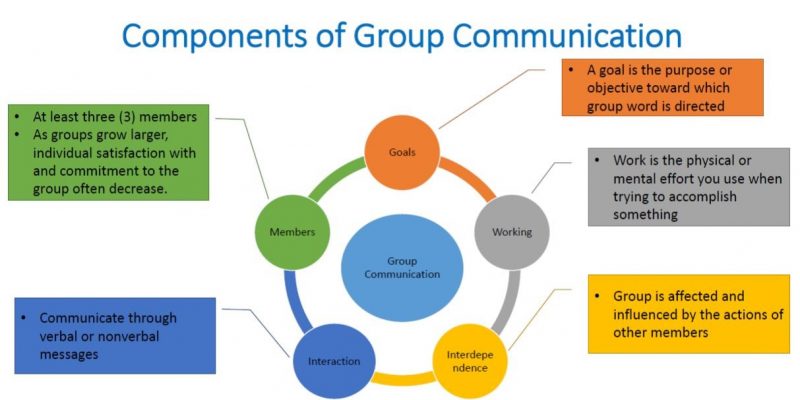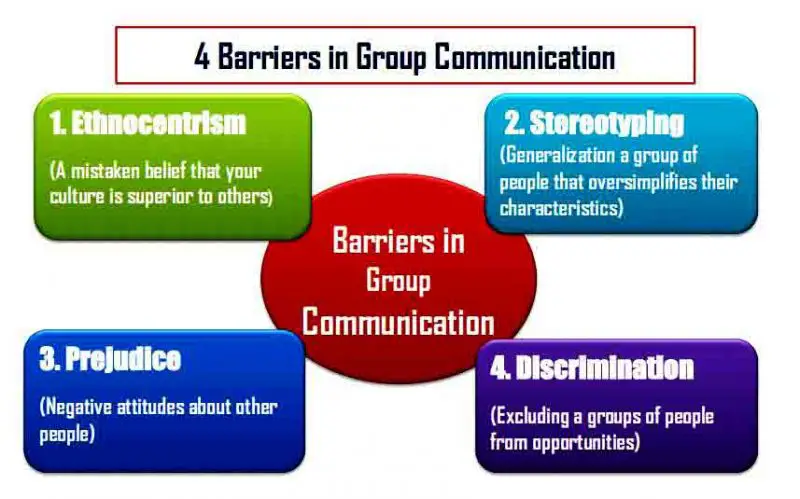Group communication Definition, Elements, Barriers & Example. Also, Characteristics of Group Communication.
Group Communication
Group communication refers to the regular discussion among a group of people who communicate to achieve a goal. It is also known as group or team discussion. Group members discuss completing an independent and interdependent goal. An interdependent goal is mutual in which many people work together to achieve the same purpose. On the other hand, an independent goal refers to one person’s dream. Group discussion occurs when people communicate regularly to complete a group task.
Group Definition in Organizational
A group refers to two or more employees who freely interact with individuals, and share common norms, goals, and identity. The two most common types of groups are formal and informal which can overlap.
Formal Groups: A formal group is assigned by an organization to accomplish specific goals. and fulfill two basic functions: organizational functions and individual functions.
Informal Groups. The overriding purpose for meeting is friendship or common interest.
Small-Group Communication
Example of Group Communication
A real-life example of group communication is group study. For example, a few students regularly sit together to discuss how to complete the assignments given by the lecturers. The group members meet before or after the class to share their opinions and suggestions. They continue their discussion until the project is completed. So, the continuous interaction among a group of students for the assignment completion is an example of group discussion.
The most common example of group discussion is virtual group communication. Nowadays, educational institutes offer virtual learning. It allows connecting students far from each other beyond geographical borders. To complete the group assignment, the students create a virtual group to communicate through virtual meeting platforms such as Zoom, Google Meet, Skype, and more. They communicate regularly to complete the assignment and presentation. Many lecturers instruct their students to submit the virtual meeting minutes sample.
Five examples of small group communication
Example of social group is classmate learning group, team group, employee working group, business group, virtual group, family group, and political group discussion.
Characteristics of Group Communication
The seven characteristics of group communication are Size, Goals, Norms, Roles, Structures, Discussion, and Collective Identity.
Group Communication Elements
There are many elements or components in group communication. Group elements are essential components to form an active group as well as achieve a common goal. An influential group must have or fulfill all elements to understand an interdependent plan. The essential characteristics of group communication are common goals, members, interaction, interdependence, and working.
The 5 Components of Group Communication are:
- Goals
- Members
- Interaction
- Interdependence
- Working

1. Goal
The goal is essential to group communication because every group or team intends to achieve a goal. A goal is a purpose or objective toward which the group work is directed; therefore, all group members are aware of achieving that goal. Every group has its specific common goal or interdependent goal and the independent goal of the group members. The opinions of group members have selected the common goal.
2. Members
Members are another essential element or component of the group. At least three (3) members can form a small group, and 18 is the maximum number. As groups grow larger, individual satisfaction with and commitment to the group often decrease. A Group can not be formed without members, so every group must consist of some members. Members are the most important in forming groups; hence, they must follow some ethical principles in group communication.
Ethical Principles of Group Members
1. Group members should be willing to speak
2. Group members should embrace and work with diversity within the group
3. Group members should always treat one another with respect
4. Group members should be thorough in gathering information as well as diligent in evaluating it.
5. Group members must contribute their fair share to the group’s effort.
6. Group members must conduct themselves with honesty and integrity.
A social loafer refers to a person who makes a minimal contribution to the group and assumes the other members will take up the slack—the willingness of every group member to be a participant. The group member should be collaborative and have cohesive behavior, but not social lofting. Effective group communication is about what you can do in groups and what you should do.
3. Interaction
Interaction denotes communication among group members through verbal or nonverbal communication messages. Additionally, it will happen among group members intentionally or unintentionally through verbal or nonverbal cues.
4. Interdependence
The group is affected and influenced by the action of other members. Therefore, group communication must be interdependent to motivate team or group members.
5. Working
Work is the physical or mental effort you use to accomplish something. It is also one of the essential elements of group communication in which the group goes ahead.
The components are also known as characteristics or features of group communication. These characteristics ensure the effectiveness of the group discussion.
Group Communication Barriers
Barriers to Group Communication are disturbances that are obstacles to interactive communication among group members. The barrier in group discussion usually hiders to understanding other members of the group or team. The group discussion has many stages, tensions, conflicts, etc. According to Tuckman’s model, the five stages of group discussion are Forming, Storming, Norming, Performing, and Adjourning. Members need to overcome all these stages to achieve the independent and interdependent goal. The four types of barriers in group communication are Ethnocentrism, Stereotyping, Prejudice, and Discrimination.
Group Communication Barriers
Barriers in group communication are also known as noises in group communication. These barriers or noises in communication are prevalent in every context of the communication process, for example, barriers in the face to face communication, mediated communication, corporate communication, and group communication. Barrier or noise is an unwanted element of the communication process.

The 4 Types of Barriers in Group Communication
- Ethnocentrism
- Stereotyping
- Prejudice
- Discrimination.
1. Ethnocentrism
Ethnocentrism refers to a mistaken belief that your culture is superior to others, with special rights and privileges that are or should be denied to others. It is not about patriotism or pride. Ethnocentrism is an excellent barrier that obstacle to effective communication among the group or team members.
For example, my culture should be a role model for other cultures. People would be happier if they lived like people in my culture.
- Furthermore, most other cultures are backward when compared with my culture.
- For example, Have you ever been insulted by someone who implies that their religious beliefs are “true,” whereas yours are not?
- For instance, Have you been disrespected by someone who believes that his traditions, language, or music preferences are “better” than yours?
2. Stereotyping
Stereotyping means generalization about a group of people that oversimplifies their characteristics. It relies on exaggerated beliefs to make judgments about a group of people. For example, Malays are lazy; Chinese are greedy and rich; Indians are drunker; Singaporeans are “kiasu”. Negative traits to an entire group when, in reality, only a few people in that group may possess those traits. In another instance, Asian students are good at Mathematics(Positive stereotypes).
3. Prejudice
Prejudice refers to the negative attitudes about other people that are based on faulty and inflexible stereotypes. Prejudice mostly brings negative consequences. For example, “He cannot be brilliant if he only has a Bachelor’s degree from XX University or College. In addition, “I don’t want a person with disabilities working on our group project.”
- Stereotyping ⇒ Prejudice
- Characteristics of Prejudice:
-
- Firstly, they are rarely based on extensive direct experience and first-hand knowledge.
- Secondly, the result is irrational feelings or dislike and even hatred for specific groups.
- Finally, they justify a readiness to behave in harmful and unjust ways toward group members.
4. Discrimination
Discrimination describes how we act out and express prejudice. When we discriminate, we exclude people from opportunities granted to others: employment, promotion, housing, political expression, and equal rights. For example, Racial, ethnic, religious, gender, sexual harassment, sexual orientation, disability, age, and people from different social and political classes.
Difference Between Group and Team
According to our research data, the group and team describe almost the same characteristics, although they contrast in the level of performance. The team members are highly collaborative, dedicated, and competent compared to the group members.
Group Communication
Group discussion occurs when a group of people regularly interact to achieve a common goal.
For example, Student Learning Group, Morning jogging group, and so more
Team Communication
Francis and Young (1992) defined a Team as a “high-performing task group whose members are actively interdependent and share common performance objectives. A group of members (people) shows closer cooperation and cohesiveness.
For example-Football Team
Players come together to win the match. Here, winning the game is the common goal, and players are team members similar to the group.
Team Types
Teams can be distinguished by purpose, duration, and level of member commitment.
1. Work Teams: The work team operates to achieve a common objective, typically these teams are permanent and demand full commitment from members.
Project Teams: Project teams intend to complete specific problems, tasks, or projects. Usually, members form this group for a particular duration to complete a project.
Self-managed Teams: Admin authority from this team to regulate task domain including staffing, oversight, and scheduling.
Cross-functional Teams: This group is formed with diverse members for example, when experts from different areas are put on the same team.
Virtual teams. Teams that work together over time and distance via electronic media to combine effort and achieve common goals.
How Are Teams Different from Groups?
A group becomes a team when:
- Leadership becomes a shared activity.
- Accountability shifts from strictly individual to both individual and collective.
- The group develops its purpose or mission.
- Problem-solving becomes a way of life, not a part-time activity.
- Effectiveness is measured by the group’s collective outcomes and products.

Great post! I completely agree with the definition of group communication and the examples you provided. It’s so important to understand the characteristics of group communication in order to effectively communicate with others in a group setting. I find that the concept of “groupthink” is especially relevant in today’s society, where people often feel pressure to conform to the opinions of the group rather than speaking their minds. Thanks for sharing your insights!
wow this was awesome,I love this article
it really helped me í ½í¸í ½í¸í ¾í´
It’s very interesting to read because it was defined Well thank u a million